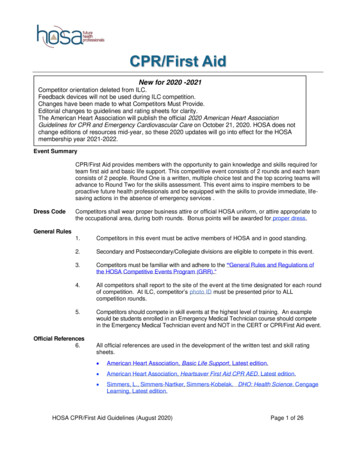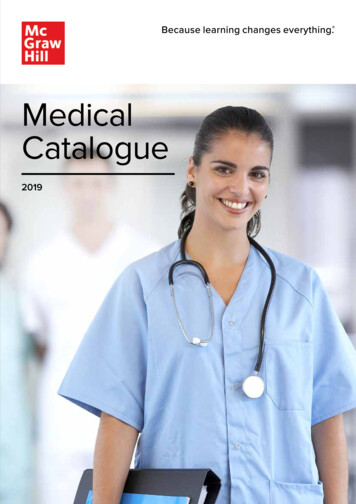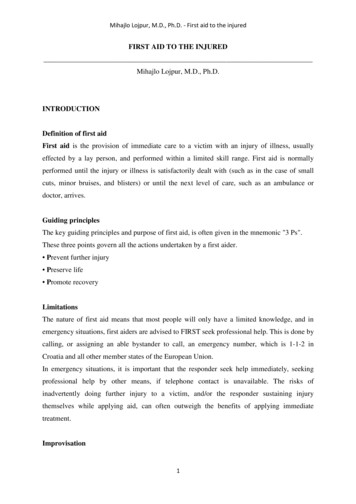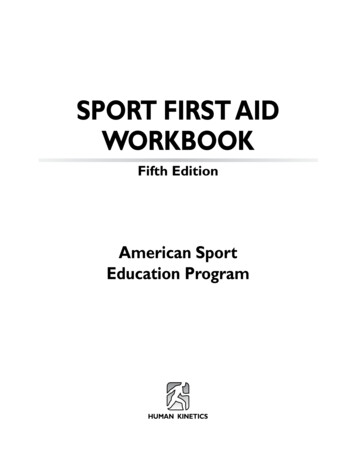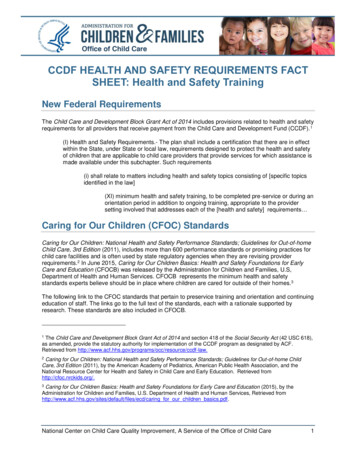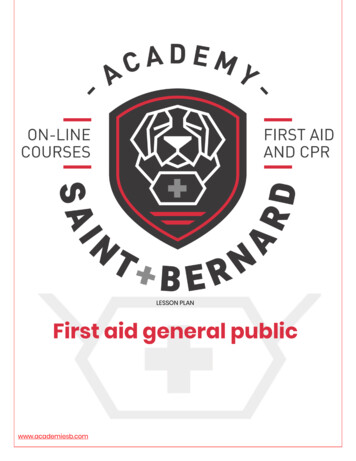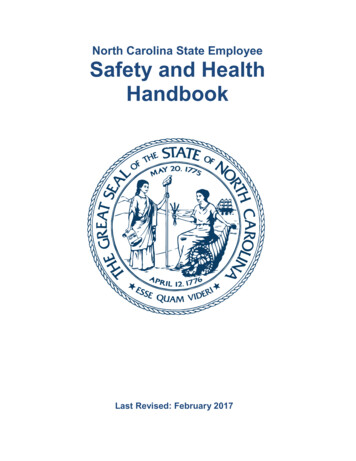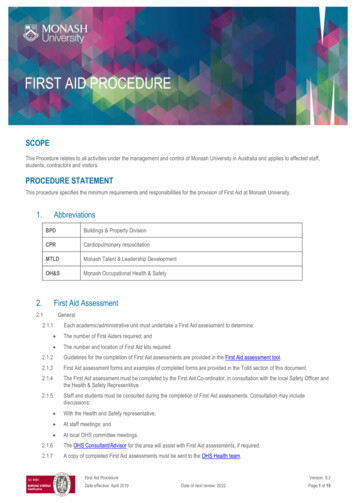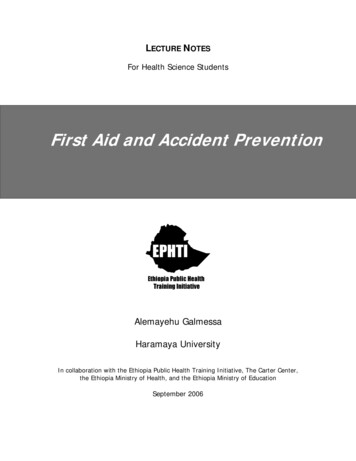
Transcription
LECTURE NOTESFor Health Science StudentsFirst Aid and Accident PreventionAlemayehu GalmessaHaramaya UniversityIn collaboration with the Ethiopia Public Health Training Initiative, The Carter Center,the Ethiopia Ministry of Health, and the Ethiopia Ministry of EducationSeptember 2006
Funded under USAID Cooperative Agreement No. 663-A-00-00-0358-00.Produced in collaboration with the Ethiopia Public Health Training Initiative, The CarterCenter, the Ethiopia Ministry of Health, and the Ethiopia Ministry of Education.Important Guidelines for Printing and PhotocopyingLimited permission is granted free of charge to print or photocopy all pages of thispublication for educational, not-for-profit use by health care workers, students orfaculty. All copies must retain all author credits and copyright notices included in theoriginal document. Under no circumstances is it permissible to sell or distribute on acommercial basis, or to claim authorship of, copies of material reproduced from thispublication. 2006 by Alemayehu GalmessaAll rights reserved. Except as expressly provided above, no part of this publication maybe reproduced or transmitted in any form or by any means, electronic or mechanical,including photocopying, recording, or by any information storage and retrieval system,without written permission of the author or authors.This material is intended for educational use only by practicing health care workers orstudents and faculty in a health care field.
PREFACEThe need for first aid training is greater than ever because ofpopulation growth throughout the world due to the increased use calappliances in everyday use at home, working place and play areas.These make more and more people at risk of injury. Moreover,despite the limited amount of data available on injury epidemiology,it is becoming increasingly apparent that injuries will become animportant contributor to morbidity and mortality in Ethiopia.This is the reason why a need-based training program, which istarget oriented and task based, was established to tackle majorproblems of the nation.However, majority of Universities and Colleges who are traininghealth science students in the country are in critical shortage ofteaching learning materials, including first aid and accidentprevention training materials.In order to minimize these problems, the Ethiopian public HealthTraining Initiative, which is supported and sponsored by The CarterCenter and USAID, recognized the problem. The problem wasdiscussed among the Health center team training Universities andcolleges (Jimma University, University of Gondar, Addis AbabaUniversity, Hawassa University, College of Health Sciences andi
Haramaya University). Finally agreement was reached among theUniversities to develop lecture notes on different subjects.This first aid and accident prevention lecture note series is set up tobe simply utilized as a study and reference material by nurses andother category of health science students as well as teachers.Each chapter in this material contains the following components.(a). Objectives at the beginning of each chapter to guide students intheir study,(b). Bold face terms for students use.(c). Study questions related to each chapter.(d). Bibliography suitable for beginning students are listed at the endof material.It is believed that this lecture note fills the gap created due toshortage of teaching learning materials and brings the Universitiesclose together in terms of institutional teaching and learningstrategies to minimize variations. Hopefully, this manual would beutilized effectively to minimize the shortage of material, prevent andalleviate morbidity, disability and mortality caused as a result ofaccidents and disasters in all human environment nationwide.Initially, this teaching material was published in 2003 for diplomanurses. Currently due to the national change of educational policy,diploma programs are phased out from Universities. Therefore, thisteaching material should be standardized to the degree level; that iswhy this lecture note series is needed to be revised for the secondtime.ii
ACKNOWLEDGEMENTFirst and foremost I would like to forward my gratitude to EPHTI(The Carter Center) and USAID for the initiative and all assistance todevelop this lecture note series.I would like to address my appreciation to Haramaya University,particularly to Professor Belay Kassa, president of the University andAto Melake Demena, dean of faculty of health sciences for thecontinuous support and facilitation for the development of thismaterial, as well as for the effort made to give value for the firstpublication. I would like to extend my appreciation to the faculty stafffor their valuable support in the development of the draft.Furthermore I extend my deep appreciation to inter institutionalreviewers from all sister institutions of all EPHTI members (AddisAbaba, Gonder, Jimma, Hawassa Universities and DefenseUniversity College).I extend my gratitude to Professor Dr. Joyce Murrey, Nell HodgsonWoodruff School of Nursing, Atlanta Georgia and Ato BerhaneGebrekidan for their intensive and meticulous revision to finalize thislecture note, without it, it would have been impossible to finalize thematerial.Last but not least, I would like to thank W/t Mahidere Nigussie forher cooperation in typing the first draft of this lecture note series.iii
TABLE OF ble of contentsivList of TablesviList of figuresviiList of abbreviationsixCHAPTER – ONE: Introduction to first aid1CHAPTER–TWO: Respiratory emergencies and9artificial respirationCHAPTER – THREE: Wounds32CHAPTER-FOUR: Dressings and bandaging51CHAPTER –FIVE: Specific injuries65CHAPTER –SIX:78ShockCHAPTER – SEVEN:Bone and joint injuries83CHAPTER – EIGHT: Poisoning109CHAPTER-NINE: Burns122and137CHAPTER–ELEVEN: Heatstroke, heat sand Heat exhaustionCHAPTER - TWELVE: Emergency rescue and155short distance transferCHAPTER –THIRTEEN: Disaster170Glossary175iv
Annex I. Answer Key for Study Questions177Annex II First aid kits and supplies.182References183v
LIST OF TABLESTablesPagenumberTable 1. Essential Points to be considered whilegiving first aid treatment7Table 2.Effects of fumes Inhalation25Table 3: Possible signs of internal bleeding38Table 4: Chest Trauma and Thoracic injuries74Table 5: Recognizing and treating the effects ofpoisoning111Table 6: First aid measures of burns according totheir causes130Table 7:exhaustion146Differentiatingheatstrokeviandheat
LIST OF FIGURESFigure 1: Steps of mouth to mouth respiration13Figure 2: Mouth to mouth respiration15Figure 3: Steps in mouth to nose respiration16Figure 4: First aid measure of obstructed air way17Figure 5: First aid measure during choking for adults andchildren19Figure 6: First aid measure during chocking for adults21Figure 7: External cardiac massage30Figure 8: Abrased wound33Figure 9: Incised wound34Figure 10:Laceration35Figure 11: Puncture35Figure 12: Avulsions36Figure 13: Direct pressure40Figure 14: Elevation41Figure 15: Pressure on supplying artery42Figure 16: Application of arm sling56Figure 17: Application of bandages for scalp and fore head56Figure 18: Application of cravat bandages for forehead, earsor eyes57Figure 19: Application of cravat bandages for cheeks or58earsFigure 20: Anchoring bandage59Figure 21: Circular turning of bandage60Figure 22: Figure of eight bandage for hand and wrist61vii
Figure 23: Fingertip bandage62Figure 24: Figure of eight bandage for the ankle joint63Figure 25: Eye injuries66Figure 26: How to feel signs and symptoms of shock80Figure 27: Closed fracture84Figure 28: Open fracture84Figure 29: Splinting the legs87Figure 30: Applying arm sling for fracture of scapula91Figure 31: Appling a splint for upper arm fracture92Figure 32: Splinting the fore arm94Figure 33 A and B: Splinting fracture of the upper leg97Figure 34: Splinting fracture of the knee cap99Figure 35: Splinting fracture of the lower leg100Figure 36: Splinting the ankle and foot101Figure 37: Common dislocation sites102Figure 38: First aid measures for sprain104Figure 39: Application of firm cord above the snakebite120Figure 40: First degree burns124Figure 41: Second degree burns125Figure 42: Third degree burns127Figure 43: Heat stroke148Figure 44: Heat exhaustion152Figure 45:Blanket lifting161Figure 46A and B: Three-man victim lifting164Figure 47: Six-man lifting and carrying steps’165viii
LIST OF ABBREVIATIONS1.AIDS – Acquired Immuno- deficiency Syndrome2.CO – Carbon monoxide3.CPR - Cardiopulmonary resuscitation4.HIV – Human immunodeficiency virus5.NPO - Nothing per os (nothing by mouth)ix
CHAPTER ONEINTRODUCTION1.1. Learning ObjectivesAfter studying the material in this chapter, the student will be able to:1.Define first aid2.Recognize the reasons why first aid is given3. Appreciate values of first aid4. Identify general directions for giving first aid1.2. DefinitionFirst aid is the immediate care given to a person who has beeninjured or suddenly taken ill. It includes home care if medicalassistance is not available or delayed. It also includes well selectedwords of encouragement, evidence of willingness to help, andpromotion of confidence by demonstration of competence (Americanred cross, 1998).1.3. Reasons for First Aid giving To sustain (preserve) life.E.g. mouth to mouth respiration when breathing has stopped. To prevent worsening of the problem (complication).E.g. Immobilizing the fractured bone. To promote healing and recovery.1
e.g., reassure the patient, relief pain, protect from cold and arrangepatient transferValues of First Aid TrainingThe need for first aid training is greater than ever because ofpopulation growth through out the world and due to the increaseduse of technological products; such as mechanical and electricalappliances in everyday use at home, working place and play areaswhich make more people at risk of injury. Thus, there is an evergrowing demand for first aid training for personal use and from thedemand for certified first- aiders as part of industrial and commercialestablishments. In general first aid is aimed to help for others,preparation for knowing what to do during disaster as well as to helpself.1.4. General directions to give first aidResponsibility of a first -aider in the management of casualty: Assessment of the situation Identify the problem Giving immediate and adequate treatment, bearing in mind thata casualty may have more than one injury and that somecasualties will require more urgent attention than others (to givepriority). Arrangement for the transport of casualty according to theseriousness of his/her condition with out delay accompaniedwith brief written report. Prevent cross infection2
1.4.1. Assessment Be calm, take charge and be confident Talk, listen and reassure the conscious casualty Check safety of casualty and of yourself and check forbreathing, bleeding and level of consciousness. Get others to help.3
Assessing a casualtyPrimary survey algorithmStarthereASSES THE SITUATION Are there any risks to you orthe casualty?YesPut your safety first anddeal with any danger,when it is safe;NOASSESS THE CAUSALTY Is the casualty conscious?Does he respond to questions and to gentileshaking or tappingYesTreat the casualty and DIALL forAMBULANCE if necessaryNO Shout for helpOpen the air wayCheck breathingIs the causality breathing?YesPlace in the recoveryposition and DIALL FORAMBULANCENODIALLFOR AN AMBULANCE: send a helperBREATH FOR THE CAUSALITY Give 2 effective rescue breathesASSESS CIRCULATION Look for signs of circulation such as breathing ,coughing, or movement Are there any signs of circulation?NOCOMMENCE CPR Adult: Alternate 15 chest compressions with 2rescue breathes Child/ baby: Alternate 5 chest compressionswith 1 rescue breathe. Continue until healp arrives.4YesCONTINUE with rescuebreathes. Look for signs ofcirculationaftereveryminute
Source: First aid manual, Emergency procedures for everyone, athome, at work, at leisure, 8th edition(P.29)1.4.2. Problem identification (Diagnosis)The history of the incident must be taken in to consideration and anexamination made to determine the signs and symptoms and levelof consciousness.History:-The story of how the accident happened or the illnessbegan can be obtained from: The causality ( e.g. I slipped and fall down) A witness or a bystander(s) whether he/she saw the happeningsPoints to be considered during history taking:Any history of illness: Eg. Epilepsy, Diabetes mellitus,For history of ingested material E.g. Drug, Alcohol, type of food orfluidSymptoms:- Sensations and feelings that are described by thecasualtyE.g. I feel pain I feel cold my arm is numbSigns:- variations from normal ascertained by the first- aider.E.g. Pallor of the inner surface of the eyelids or nail beds;blueness (cyanosis) of face, lips, fingers and toes. Theremay be evidence of poisoning e.g. medications, alcoholicsmell, bottles and other containers beside the victims.5
Level of consciousness:Recognition of any change of level of consciousness is important. Full consciousness- the casualty is able to speak and answerquestions normally Drowsiness- the casualty is easily aroused but lapses in tounconscious state Stupor –the casualty can be roused with difficulty, aware ofpainful stimuli.E.g. pin prick, but not of other external elements like beingspoken to. Coma - cannot be roused by any stimuli.In general make full use of your senses to obtain maximuminformation (Look, smell, listen and touch).Action: - If the cause of the condition is still active, remove thecause.E.g. -a lodging of wood on the causalities leg, contaminated clothingor remove the causality from the cause, such as traffic, fire, water,poisonous fumes. etc.6
Table 1. Essential Points to be considered while giving first aidtreatmentTo sustainTo preventTo promote(preserve) life.worsening of thehealing andproblemrecovery.Finally(complication). Emergency resuscitationPrevent the Place the with out delay toconditioncasualty infromcorrectbecomingand worsecomfortabl (complicatioe positionhome or to hospitalTransport the victimIn a serious casesummon(inform)n) Convey the causalityahealth personalCoverwounds Immobilize Reassurebleedingfractures, Give anyand shocklargeotherwounds andtreatmentany injuredneededshould be sent to theRelievefamily if necessary topaintell the family4 whatControl par Handlethe causality A tactful messageandwas happened andcarefully atwhere he has beenall timestaken, unless it hasgently A brief written reportshould accompanyMoveasbeen done by thelittleaspolice or otherauthority.possibleProtect fromcold.7
1.5. Study Questions1. Define first aid2. Describe reasons why first aid is given3. What are the values of first aid?4. What are the general directions to be followed while givingfirst aid?5. In the case of occurrence of an injury to a victim if thecondition is still active, remove the cause or the victim fromthe cause.TrueFalse8
CHAPTER TWORESPIRATORY EMERGENCIES ANDARTIFICIAL RESPIRATION2.1. Learning ObjectivesAfter studying the material in this chapter, the student will be ableto:1.Define respiratory emergencies and artificial respiration.2.Explain the breathing process.3.Identify causes of respiratory failure4.Prevent respiratory accident, give artificial respiration andmanage respiratory accident.2.2. DefinitionRespiratory emergency is one in which normal breathing stops or inwhich breathing is reduced so that oxygen intake is insufficient tosupport life.Artificial respiration is a procedure for making air to flow into and outof a person’s lungs when his natural breathing is inadequate orceases.2.3. The breathing processNatural breathing is accomplished by increasing and decreasing thecapacity of the chest and the lung. Atmospheric air being under9
pressure, rushes in and out with the increase and decrease of chestspace.During the inhalation phase of breathing (inspiration), the muscles ofthe chest lift the ribs, expanding the chest. At the same time thediaphragm contracts and descends toward the abdomen. In thisway, the chest cavities increased in size and air flows in. When allmuscles relax, the ribs and diaphragm resume their normal position,the chest cavity becomes smaller, and air flows outward. In allmanual methods of artificial respiration, the objective is to cause analternate decrease and increase in size of the chest cavity. Whenthis is done, air flows in and out if there is no obstruction.2.3.1. Causes of Respiratory FailureA. Anatomical ObstructionThe most common cause of respiratory emergency is interferencewith breathing caused by the drooping of the tongue back andobstructing the throat. Other causes of obstruction that constrict theair passages are: Asthma Croup Diphtheria Laryngeal spasm Swelling after burns of the face Swallowing of corrosive poisons Direct injury caused by a blow10
B. Mechanical Obstruction Solid foreign objects lodging in the respiratory passage e.g.choking of food Accumulation of fluids in the back of the throat (mucous ,bloodor saliva) Aspiration (Inhalation of any solid or liquid substance)C. Air Depleted of Oxygen or Containing Toxic Gases Asphyxia – Is a condition in which there is a lack of oxygen inthe blood and the tissue do not receive an adequate supply ofoxygen. It may occur due to decreased oxygen in the air orincreased carbon monoxide (CO) or other toxic gases e.g.,mining area, sewer etc. Explosion hazard -Combustible gases that accumulate inconfined spaces where natural or manufactured gases are freein the air, and are explosive in certain concentrations. Theexplosion may result if a flame is introduced, if static electricity isdischarged or if an electric switch doorbell, telephone or otherdevice is used.D. Additional Causes of Respiratory Failure are: Drowning Circulatory collapse (shock) Heart disease11
Strangulation Lung disease e.g. pneumonia Poisoning by alcohol, barbiturate, codeine etc. Electrical shock Compression of the chest e.g. accident2.4. Artificial Respiration and Management ofRespiratory AccidentsA. Objectives:1. To maintain an open air way through the mouth and nose (orthrough the stoma)2. To restore breathing by maintaining an alternating increaseand decrease in the expansion of the chest.B. General Information The average person may die with in 4- 6 minutes if his/heroxygen supply is cut off. Recovery is usually rapid except in case of carbon monoxidepoisoning, over dosage of drugs or electrical shock. In suchcases, it is often necessary to continue artificial respiration for along time. When a victim revives he/she should be treated for shock. A physician’s care is necessary during the recovery period. Artificial respiration should always be continued until :¾The victim begins to breath by himself12
¾He/she is pronounced dead by a doctor or he/she is deadbeyond any doubtC.Mouth- to- mouth (mouth- to- nose) method or” kissof life”Steps in mouth- to- mouth or mouth- to- noserespiration Determine consciousness by tapping the victim on shoulder andasking loudly ''Are you OK''? Tilt the victim’s head back so that his/her chin is pointingupward. In this case the two procedures can be applied, i.e.head tilt- neck lift and head tilt and chin lift. (fig.1). Place your cheek and ear close to the victim’s mouth and nose.Look at the victim’s chest to see if it rises and falls; listen andfeel for air to be exhaled for about 5 seconds. If there is no breathing, pinch the victim’s nostrils shut with thethumb and index finger of your hand i.e. pressing on the victim’sforehead. Blow air in to the victim’s mouth.13
Figure 1 Steps of mouth to mouth respiration (steps of opening air way)Steps for mouth to mouth respiration. Open your mouth wide. Take a deep breath. Seal your mouth tightly around the victim’s mouth and with yourmouth forming a wide open circle and blow into the victim’smouth (fig.2). Initially give four quick full breaths without allowing the lungs tofully deflate (empty) between each breath. Maintain the head tilt and again look, listen, and feel forexhalation of air and check the pulse for at least 5 seconds butnot more than 10 seconds. If no pulse and breath docardiopulmonary resuscitation (CPR). If there is pulse and no breath, provide at least one breath every5 seconds or 12 per minute for adults and this provides sufficientair. If the airway is clear only moderate resistance to blowing will befelt.14
Figure 2Mouth- to- mouth respiration Watch the victim’s chest to see when it rises. Stop blowing when the victim’s chest is expanded and check forexhalation Watch the chest to see that it falls. Repeat the blowing cycle. For the mouth -to -nose method maintain the backward head -tiltposition with the hand on the victim’s forehead and use yourother hand to close the victims mouth. (fig.3).15
Figure 3Steps in mouth -to -nose respirationNote: Mouth- to- mouth and -nose resuscitation are administeredfor infants and children as described above except that thebackward head tilt should not be as extensive as that ofadult. Both the mouth and nose of the infant or child shouldbe sealed off by your mouth. Blow in to the infant’s mouthand nose once every 3 seconds (about 20 times perminutes). But in the case of children blow once every 4seconds (about 15 times per minute). The amount of air isdetermined by the size of the victim.16
NB: - Nowadays this practice is questioned by many people as tothe possibility of transmission of HIV/ AIDS and needs maximumcare or needs alternative procedure to save life in both cases (thevictim and the first aider). Therefore this needs recent information forbetter practice.D. Obstructed airway - unconscious victim If you are not getting air exchange, reposition the head andagain attempt to ventilate. If you still do not get an air exchange immediately turn the victimon his side towards you, resting his chest against your kneesand administer four sharp blows between the shoulder blades(fig.4). Place the victim on his back (supine) and spread legs wideapart, straddle his hips or one thigh. This position gives comfortfor the first -aider.17
Figure 4First aid measure for obstructed air way Open the victim’s airway and sweep with the fingers. If the procedures are ineffective, you must repeat the sequence. Attempt to ventilate. Perform four rapid back blows Perform four thrusts (push on the chest ) Do finger sweep If the stomach is building gastric distention, turn the adultvictim to one side and clear the mouth after pressing yourhand briefly and firmly over the upper abdomen between therib margin and the navel. This procedure will force air out ofthe stomach. But it may also cause regurgitation.E. Obstructed Air Way - Conscious Victim: The urgency of thissituation can not be over emphasized. Immediate recognitionand proper action are essential if the victim has good air18
exchange with only partial obstruction and is still able to speakor cough effectively. Do not interfere with his attempts to expel aforeign body. If the victim can not speak or cough, shows adistress signal, appears cyanotic or reveals an exaggeratedeffort to breathe, you must intervene appropriately.F. Ingested and Inhaled Objects (Choking)A small piece of food or a bone (foreign body), may be inhaledin to the wind pipe when eating. Most people on such occasionsare able to cough it up at once. Some times, however, this maynot be possible and help is needed.Do not try to hook the foreign body out with your fingers; this is likelyto push it further down. Do the following at once.19
Figure 5 First aid measure during choking for adults and children’sFor babies and small children (under one year) Hold the baby up side down by the feet and smack him firmlybetween his shoulder blades three to four sharp slaps (fig.5).GIVE UP TO FIVE BACKSLAPS Check the mouth andremove any obviousobstruction.If the obstruction is stillpresentGIVE UP TO FIVECHEST THRUSTS Check the mouthand remove anyobviousobstruction.If the obstruction doesn’tclear after three cyclesof back slabs and rivesFor Children (1-7 years) Lie the child face down over your knee or arm and smack themsharply between their shoulder blades three to four sharp slaps.Iftheobstructionisstill present orthechildisgetting weakerGIVE UP TOFIVEBACKSLAPS Check themouth andremoveanyIftheobstructionisstill presentGIVE UP TOFIVECHESTTHRUSTS Check themouth ll presentGIVE UP TOFIVEABDOMINALTHRUSTS Check themouth andremoveanyobvious20If theobstructiondoesn’t clearafter threecycles of backslabs, chestthrusts, andabdominalthrustsDIALL FOR ANAMBULANCEContinue until
For AdultsMethod - AStand behind the patient and grasp them around the chest justunder the chest bone (sternum). Give a sharp bear hug (fig.6).If the obstruction is stillpresent or the causalityis getting weakerGIVE UP TO FIVEBACK SLAPS Check the mouthand remove anypreviousobstructionIf the obstruction isstill presentGIVE UP TO FIVEABDOMENALTHRUST CheckthemouthandremoveanypreviousIf the obstruction doesn’t clearafter three cycles of backslabs and abdominal thrustsDIALL FOR AN AMBULANCEContinue until help arrivesMethod - BTell the patient to lean over the back of the chair holding on to theseat and then bang him sharply three or four times between hisshoulder blades.Whichever method you use, the foreign body should be coughedout. When a very soft food, drink, blood or vomitus has beenbreathed in, place the patient in the recovery position and clear hismouth off any food or vomitus with your finger (wrapped in a softclean cloth). If the breathing has stopped begin mouth-to -mouthrespiration.21
Figure 6. First aid measure during choking for adults2.5.DrowningIt is the fourth leading cause of accidental death in the active agegroups. Major drowning ranks second in fatality only to motor vehicleaccidents; the majority occurs in the recreational play or leisure timeactivities in developed countries.The aim of giving first aid for drowning is:To restore adequate breathingTo keep the casualty warmTo arrange urgent removal to hospitalFirst aid measure.22
1. If you are rescuing the casualty from the water to safety, keep thehead lower than the rest of the body to reduce their risk of inhalingwater.2. Lay the casualtyPrevention of accidental drowning involves: Supervision during swimming. Protection of the swimming area and the swimmer. Training of the swimming person and life savers.2.6. Mechanical suffocation (Strangulation)If pressure is exerted on the outside of the neck, the air way issqueezed and the flow of air to the lung is cut off. The main causesof such pressure are: Hanging- suspension of the body by rope around the neckor throat. Strangulation- constriction or squeezing around the neck orthroat.Sometimes, hanging or strangulation may occur accidentally- forexample, by ties or clothing becoming caught in machinery.Hanging may cause a broken neck; for this reason, a casualty in thissituation must be handled extremely carefully.Recognition (signs) A constricting article around the neck Marks around the casualty’s neck Rapid, difficult breathing; impaired consciousness; grey-blueskin (cynosis).23
Congestion of the face, with prominent veins and, possibly,tiny red spots on the face or on the whites of the eyes.Caution Do not move the casualty unnecessarily, in case of spinalinjury. Do not destroy or interfere with any material that has beenconstricting the neck, such as knotted rope; police may needit as evidence.First aid aim and interventions:The aims are: To restore adequate breathing. To arrange urgent removal to the hospitalFirst aid measures are:1. Quickly remove any constriction from around the casualty’s neck.Support the body while you do so if it is still hanging. Be awarethat the body may be very heavy.2.Lay the casualtyon the ground. Open the airway and checkbreathing. If he/she is not breathing, be prepared to give rescuebreaths and chest compressions if necessary. If he/she isbreathing, place her in the recovery position.Never give an infant plastic material to play with and be certain thatmattress covers securely anchored to the bed.24
2.7.Inhalation of fumesThe inhalation of smoke, gases (such as carbon monoxide), or toxicvapors can be lethal. A casualty who has inhaled fumes is likely tohave low levels of oxygen in his/her body tissues and thereforeneeds urgent medical attention. Do not attempt to carry out a rescueif it is likely to put your own life at risk; fumes that have built up in aconfined space may quickly overcome anyone who is not wearingprotective equipment.Smoke inhalationAny person who has been enclosed in confined space during a fireshould be assumed to have inhaled smoke. Smoke from burningplastics, foam padding, and synthetic wall coverings is likely tocontain poisonous fumes. Casualties should also be examined forother injuries due to the fire.Inhalation of carbon monoxideCarbon monoxide is a poisonous gas that is produced by burning. Itacts directly on red blood cells, preventing them from carryingoxygen to the body tissues. If the gas is inhaled in to the body inlarge quantities- for example, from smoke or vehicle exhaust fumesin a confined space- it can very quickly proves fatal. However,lengthy exposure to even a small amount of carbon monoxide- foreexample, due to a leakage of fumes from defective heater or fluemay also result in sever, or possibly fatal, poisoning.25
Carbon monoxide has no test or smell, so take care if you suspect aleak.Table 2: Effects of fumes InhalationGasSourceEffectsCarbonExhaust fumes of motor vehicles.Prolonged exposure from lowmonoxide Smoke from most fireslevels: Head ache Back-draughts from blocked Confusion,Aggressi
1. Define first aid 2. Recognize the reasons why first aid is given 3. Appreciate values of first aid 4. Identify general directions for giving first aid 1.2. Definition First aid is the immediate care given to a person who has been injured or suddenly taken ill. It includes hom

